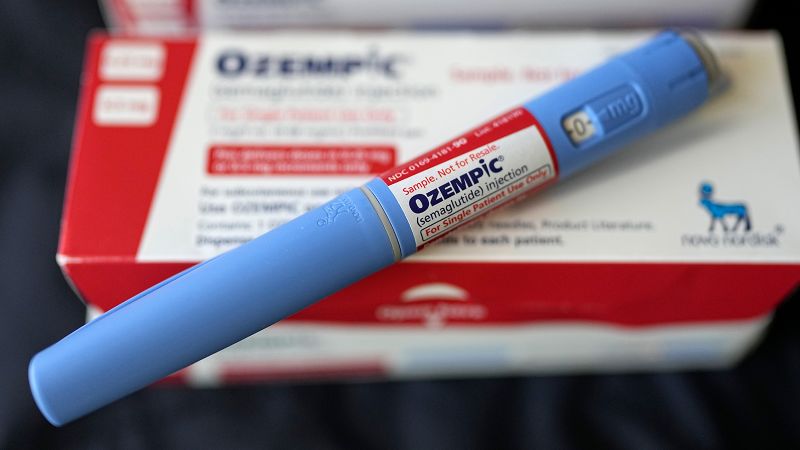Some Americans may have to shell out more this year for Ozempic and Mounjaro, two wildly popular diabetes medications also used for weight loss.
Drugmakers raised the list prices of the two drugs, along with roughly 900 other brand-name medications, in January, according to 46brooklyn, a nonprofit drug pricing analytics firm.
The median increase was 4.7%, a touch lower than the typical annual boosts since 2019 and much less than the hikes of roughly 8% to 9% that were common for several years before that.
Still, this year’s median increase outpaced inflation, which cooled to 3.1% for the 12 months ending in January.
Novo Nordisk boosted the list price of Ozempic by 3.5% to $969 for a four-week supply. The company told CNN that it increases the list prices of some medications each year based on changes in the health care system, inflation and market conditions. It noted that the annual price jumps on its drugs have not exceeded single-digit percentages since 2016.
Eli Lilly last month raised the list price of Mounjaro by 4.5% to $1,069 for a four-week supply.
Neither company hiked the list prices of their medications that are approved by the Food and Drug Administration to treat obesity. Novo Nordisk’s Wegovy costs $1,349 for a four-week supply. Eli Lilly’s Zepbound, which was approved in November, is priced at $1,060.
For most Americans, the price they pay for medications depends on their health insurance policies, not drugmakers’ list prices. However, they may have to pay the list price if they are uninsured or have not yet hit their annual deductible.
Many drug manufacturers also offer savings cards and patient assistance programs that can reduce certain people’s out-of-pocket costs. For instance, patients with commercial insurance that covers Wegovy and Ozempic may pay as little as $0 and $25, respectively, with Novo Nordisk savings cards. Those whose commercial insurance doesn’t cover anti-obesity medications can get a $500 discount on the full price for Wegovy.
Eli Lilly offers similar savings programs for Mounjaro and Zepbound, which provide a 3-month supply for as little as $25 for those with commercial insurance that covers the medications.
While employers and commercial insurers are more likely to cover GLP-1 drugs like Ozempic and Mounjaro when prescribed for the treatment of diabetes, many don’t cover medications like these for weight loss. Neither do Medicare nor most state Medicaid programs. What’s more, those enrolled in government plans don’t qualify for savings cards, though some Medicare beneficiaries may qualify for patient assistance that would supply them with Ozempic at no charge, according to Novo Nordisk.
Eli Lily told CNN that it is working with policymakers to push for legislation that would expand government insurance programs’ coverage of anti-obesity medications.
The spotty insurance coverage for drugs for weight loss means some Americans have to pay cash for the uber-popular medications, exposing them to increases in list prices.
The high cost of drugs in general has long been one of Americans’ biggest health care pain points. Even those who have health insurance that covers the medications they need may struggle to afford the out-of-pocket cost.
The price tags of Marlene Foss’ multiple medications have forced her to make some difficult decisions over the past year.
Foss, 72, was taking Entresto for heart failure, that costs $185 a month; and Farxiga to prevent kidney failure, with a $145 monthly price tag on her Medicare drug plan. She opted to stop the Entresto because she didn’t feel it was helping and didn’t want to go on a higher dose, which would have cost even more.
“I had to make a choice,” said Foss, a registered nurse who still works a few days a week to help cover her medications. “I decided to save my kidneys.”
The Doylestown, Pennsylvania, resident also opted to have a device implanted in her heart last year so she could stop taking Eliquis, a blood thinner to avoid strokes, in part because she wanted to free herself of the $500-plus bill for a three-month supply.
Medicare and her Medigap supplemental policy picked up the estimated $100,000 cost of the procedure.
Foss has other plans for the money she’s saved from working “very hard for 50 years on my feet.” She loves to travel and has a trip to Italy planned for May.
“I don’t want to just put all my money into drugs,” she said. “I want to be able to enjoy my life.”
When Mark Rapp signed up for Medicare Advantage in 2020, he was stunned to learn that the medication he takes to control the lasting side effects from gall bladder surgery would cost $150 a month — more than three times what it did under his former employer’s policy.
“I was ready to say, ‘forget it’,” said Rapp, 68, a former school psychologist who lives in Mansfield, Ohio. “And then I was like, ‘You are painted into a corner. You don’t have a choice. You have to take this medicine.’”
At first, he tried to stockpile Welchol, which prevents him from having severe diarrhea whenever he eats or drinks, by taking only a third of the recommended amount. But it didn’t work, so he was forced to go back on the full dose.

Though Rapp was able to switch to a $90 generic version of the medication last year, he still has to work full-time as a substitute teacher to help cover the expense. It’s not what he planned when he moved to Ohio from Idaho to be closer to his son and grandkids.
“I could certainly find something else to do with that 90 bucks a month, like put it into a savings account for the grandkids or use it to travel or groceries,” Rapp said. “It’s a chunk of money that I’d just as soon not be paying.”
Reducing drug costs has been one of President Joe Biden’s main talking points on the 2024 presidential campaign trail, as he seeks to highlight the ways he is providing relief to consumers.
He often cites capping the monthly tab for insulin for Medicare enrollees at $35, one of several drug price-related provisions in the Inflation Reduction Act, which Democrats pushed through Congress in 2022.
Among his administration’s most notable efforts is having Medicare negotiate the prices of certain drugs for the first time, which is expected to lower costs for the federal government. Also, drug companies have to pay a rebate to Medicare if they raise the prices of certain drugs faster than inflation, which can lower the out-of-pocket costs for some beneficiaries. Both measures were contained in the Inflation Reduction Act.
Former President Donald Trump, who is running for election again, also unveiled several proposals and issued executive orders aimed at lowering drug costs during his administration. He criticized pharmaceutical companies for price hikes.
Some drugmakers have curtailed their annual price hikes for certain medications amid increased scrutiny from the White House, Congress and patient advocacy groups. Another factor is the recent policies that penalize pharmaceutical manufacturers for raising list prices faster than inflation.
“We’ve seen a deemphasis on increases over time,” said Antonio Ciaccia, CEO of 46brooklyn. “Simultaneously, we’ve seen a greater emphasis on higher launch prices for products.”
Read the full article here





